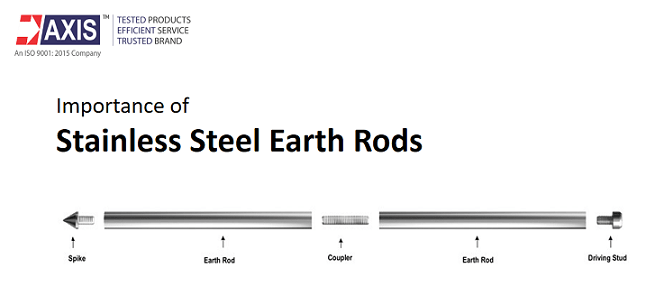Scope:
Earth rods constructed of austenitic stainless steel according to British specifications. Stainless steel rods are comparable to copper rods; however, they are more anodic than copper and can be used when galvanic corrosion is a concern. The current carrying capacity of stainless-steel rods is lesser as compared to copper. These rods have a tapped hole on either end, which allow them with a coupling dowel. If necessary, it can be in several grades.
Introduction:
Stainless Steel earth rods overcome a condition of galvanic corrosion that happens due to dissimilar metals buried nearby. Solid copper rods will most likely react negatively with the buried metal that allows corrosion. Stainless steel rods, which are more anodic than copper and resistant to corrosion, are recommended to overcome this condition. These rods are of austenitic stainless-steel grade 316, according to BS970.
Stainless Steel Earth Rod:
AXIS provides the customer with a comprehensive choice of earthing equipment that is both suitable and cost-effective.




Galvanized Steel Earth Rod- Unthreaded & Pointed:
They contain high strength low carbon steel and are hot-dipped galvanised. This earthing rod design is truly a cost-effective choice.


Important technical aspects of Stainless-Steel Earth Rods:
Copper may not be suitable with some soils and landfill locations. Stainless steel is a superior option.
Where structures or components such as steel towers, poles or lead-coated cables are close to an array of ground electrodes, stainless steel earth rods may be an option. In this situation, galvanic corrosion should be considered.
Compound for backfilling the resistivity range begins at 0.12 Ωm.
For a permanent solution to lower earth resistance, a comprehensive solution based on national and international standards IS-3043, BS-7430 & IEEE-80, IEC 62561-7 (for backfill compound), along with IEC-60364-5 should be considered.
Plate, Rod, and Strip electrodes are all compatible with SSER.
For the earthing system of power plants, transformer stations, towers, communication stations, airports, railways, subway stations, high buildings, computer rooms, petrochemical plants, and oil reservoirs in moist, saline and alkaline, acid and chemical corrosion medium environments, stainless steel earthing electrode is used.
Features of SSER:
Stainless steel earth rods are internally threaded for jointing, making them ideal for situations where galvanic corrosion could occur due to dissimilar metals buried nearby.
Stainless steel earth rods are extremely corrosion resistant, and there are a variety of earth rod driving heads, spikes, dowels, and couplers available.
According to the BS EN 10088 standard, earth rods are made of stainless steel and have good corrosion resistance in adverse conditions.
Where soil conditions are more hostile, such as places with high salt concentrations, this method is used. The overall resistivity of the earth rod and system is determined by soil variables such as temperature and type, moisture content and retention.
Stainless Steel Earth Rods contain a tapped hole on each end that permits a coupling dowel to connect them.
These rods are of austenitic stainless-steel grades SS304 and SS316.
Advantages:
Stainless steel rods are far more anodic than copper and are resistant to corrosion.
High durability and easy to install.
Excellent electrical and thermal conductivity.
Installation is easy & the appearance is elegant.
Repeatedly withstand required current as of and when required.
Have a service life of roughly 40 years in most soils.


This article is part of our series of articles on Lightning Protection, Surge Protection & Earthing, you can read more with the following links:
Introduction to the basics of Lightning Protection and Earthing and the Standards (IEC 62305 and UL 467)
Surge Protection Devices (SPD)
Lightning Protection Zones and their Application to SPD Selection
How does a Lightning Arrester work?
Thank you for reading the blog, Axis is a leading manufacturer and supplier of Electrical Components to over 80+ Countries. Talk to our industry expert by visiting our contact us section. You can also watch our videos by our experts – click here.
Follow us on LinkedIn for regular updates on our Products!
